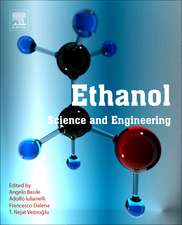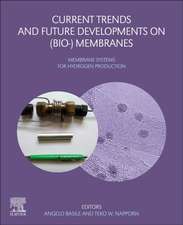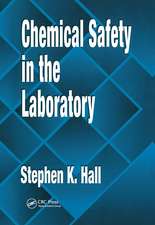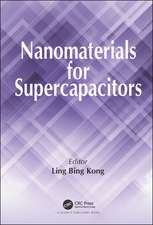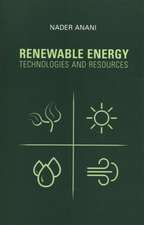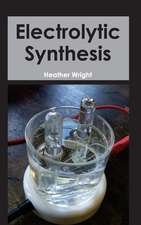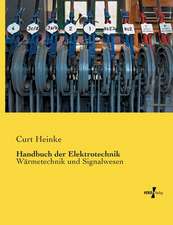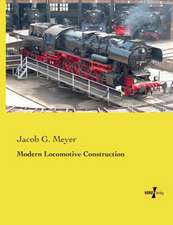Second and Third Generation of Feedstocks: The Evolution of Biofuels
Editat de Angelo Basile, Francesco Dalenaen Limba Engleză Paperback – 28 mar 2019
- Reviews existing lignocellulosic biomass feedstocks and their sources
- Includes processes for the conversion of various feedstocks to biofuels
- Discusses current research findings on second and third generation feedstocks
- Describes processes involved in the transformation of algal biomass into biofuels
Preț: 1053.61 lei
Preț vechi: 1472.04 lei
-28% Nou
Puncte Express: 1580
Preț estimativ în valută:
201.66€ • 209.74$ • 168.99£
201.66€ • 209.74$ • 168.99£
Carte tipărită la comandă
Livrare economică 06-20 martie
Preluare comenzi: 021 569.72.76
Specificații
ISBN-13: 9780128151624
ISBN-10: 0128151625
Pagini: 654
Dimensiuni: 191 x 235 mm
Greutate: 1.11 kg
Editura: ELSEVIER SCIENCE
ISBN-10: 0128151625
Pagini: 654
Dimensiuni: 191 x 235 mm
Greutate: 1.11 kg
Editura: ELSEVIER SCIENCE
Public țintă
This is a key reference text for R&D in academia and industry interested in biofuels technologies and processes; Energy producers, Bio-Engineering Companies, Bio-Process Engineering, Bio-Chemical Plants.Cuprins
Part I: From simple sugars to biofuels: The evolution of biotechnology
1. From sugars to ethanol - from the agricultural wastes to algal sources: An overview
2. First-generation feedstock for bioenergy production
3. From substrate to biofuel in the acetone-butanol-ethanol process
4. Biobutanol versus bioethanol in the acetone-butanol-ethanol technology - A chemical and economical overview
Part II: Second generation feedstocks
5. Biofuels from agricultural wastes
6. Physical and chemical pretreatment of lignocellulosic biomass
7. Biological pretreatment of lignocellulosic biomasses - Current trends and future perspectives
8. Hydrolysis: From cellulose and hemicellulose to simple sugars
9. Fermentation processes for second-generation biofuels
10. Evaluation and comparison between simultaneous saccharification and fermentation and separated hydrolysis and fermentation process
11. Physical properties and chemical composition of biofuels
Part III: Third generation feedstocks
12. Algae for biofuels: The third generation of feedstock
13. Thermochemical conversion of microalgal biomass
14. Algal cultivation for biofuel production
15. Anaerobic digestion of microalgae for biomethane production
16. Photobiological biohydrogen production
17. Transesterification of microalgae for biodiesel production
Part IV - Economical assestments and future trends
18. Coal versus biofuels. A social and economic assessment
19. An overview of current trends and future scope for vegetable oil-based sustainable alternative fuels for compression ignition engines
20. The fourth generation of biofuel
1. From sugars to ethanol - from the agricultural wastes to algal sources: An overview
2. First-generation feedstock for bioenergy production
3. From substrate to biofuel in the acetone-butanol-ethanol process
4. Biobutanol versus bioethanol in the acetone-butanol-ethanol technology - A chemical and economical overview
Part II: Second generation feedstocks
5. Biofuels from agricultural wastes
6. Physical and chemical pretreatment of lignocellulosic biomass
7. Biological pretreatment of lignocellulosic biomasses - Current trends and future perspectives
8. Hydrolysis: From cellulose and hemicellulose to simple sugars
9. Fermentation processes for second-generation biofuels
10. Evaluation and comparison between simultaneous saccharification and fermentation and separated hydrolysis and fermentation process
11. Physical properties and chemical composition of biofuels
Part III: Third generation feedstocks
12. Algae for biofuels: The third generation of feedstock
13. Thermochemical conversion of microalgal biomass
14. Algal cultivation for biofuel production
15. Anaerobic digestion of microalgae for biomethane production
16. Photobiological biohydrogen production
17. Transesterification of microalgae for biodiesel production
Part IV - Economical assestments and future trends
18. Coal versus biofuels. A social and economic assessment
19. An overview of current trends and future scope for vegetable oil-based sustainable alternative fuels for compression ignition engines
20. The fourth generation of biofuel

